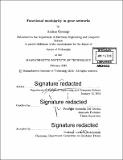Functional modularity in gene networks
Author(s)
Gyoergy, Andras
DownloadFull printable version (12.94Mb)
Other Contributors
Massachusetts Institute of Technology. Department of Electrical Engineering and Computer Science.
Advisor
Domitilla Del Vecchio.
Terms of use
Metadata
Show full item recordAbstract
This thesis addresses two sources of context-dependence in both systems and synthetic biology: retroactivity and competition for shared cellular resources. The contribution is the development of simple-to-use computational tools that aide the analysis and design of multi-module genetic systems. These tools are a result of combining mathematical modeling and theoretical analysis with experiments performed in Escherichia coli. While current approaches most often neglect to account for context-dependence in living systems, experimental evidence demonstrates that such effects have profound influence on system behavior. As a result, modules developed separately are likely to behave differently from predicted, so that they need to be redesigned through a lengthy and ad hoc process every time they are inserted into a different system. To overcome this major limitation, in this thesis I expand the description of gene circuits. First, the description of modules is appended by quantities similar to input and output impedance in electrical networks theory. Second, the description of each protein is appended by a quantity characterizing the amount of resources that are sequestered for its production. As a result, the behavior of modules upon interconnection becomes predictable, facilitating both the rational design of synthetic circuits and furthering our understanding of natural systems. Application examples are considered, which include the design of oscillators and toggle switches, network identification problems, and standard metabolic optimization problems, such as maximizing reaction rates catalyzed by multiple enzymes and maximizing the steady state concentration of heteromultimer complexes.
Description
Thesis: Ph. D., Massachusetts Institute of Technology, Department of Electrical Engineering and Computer Science, 2016. Cataloged from PDF version of thesis. Includes bibliographical references (pages 141-150).
Date issued
2016Department
Massachusetts Institute of Technology. Department of Electrical Engineering and Computer SciencePublisher
Massachusetts Institute of Technology
Keywords
Electrical Engineering and Computer Science.